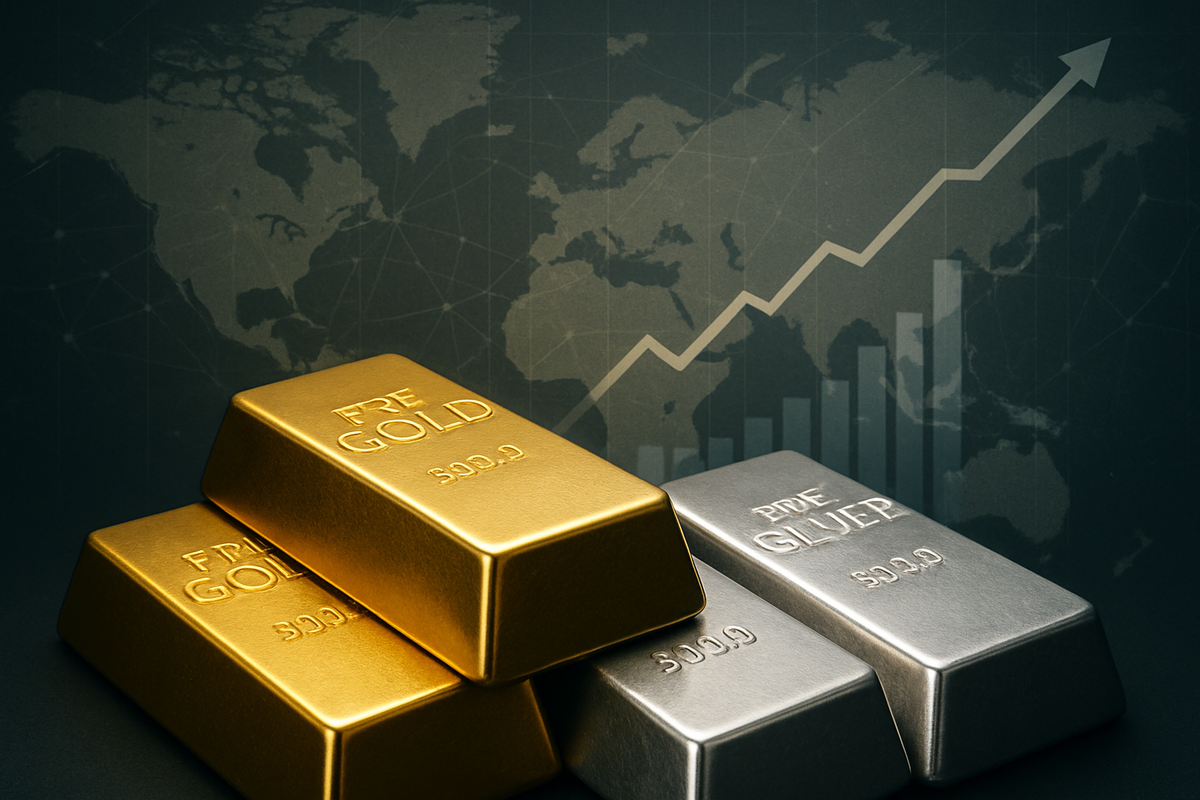
New York, NY – October 13, 2025 – Gold and silver have surged to unprecedented record highs this October, captivating financial markets and signaling a profound shift in investor sentiment amidst a landscape of escalating geopolitical tensions, persistent inflation concerns, and a global pivot in monetary policy. With gold breaching the $4,100 per ounce mark and silver soaring past $51 per ounce for the first time in over four decades, the precious metals are reaffirming their traditional roles as ultimate safe havens, drawing a significant flight of capital from riskier assets.
This historic rally underscores a deepening unease within the global economy, as investors seek refuge from a cocktail of uncertainties. The immediate implications are widespread, pointing to increased market volatility, a growing trend of de-dollarization, and a re-evaluation of investment strategies as the world grapples with a complex web of economic and political challenges.
Unpacking the Historic Ascent: A Confluence of Crisis and Policy Shifts
The ascent of gold and silver to these dizzying heights has been both rapid and dramatic. On October 8, 2025, gold prices first pierced the $4,000 per ounce threshold, culminating in an all-time high of $4,078.05 for spot gold on October 13, 2025, with international bullion briefly exceeding $4,100. In parallel, silver's performance has been equally, if not more, spectacular, with spot prices surpassing $50 per ounce and reaching an unprecedented $51.71 per ounce on the same day. This translates to a staggering year-to-date gain of over 50% for gold and a remarkable 70% for silver in 2025, highlighting an intense and sustained buying pressure.
Several potent factors have converged to fuel this extraordinary rally. Geopolitical instability remains a paramount concern, with renewed U.S.-China trade tensions, the lingering Russia-Ukraine conflict, the ongoing Israel-Hamas conflict, and political unrest in various nations contributing to a pervasive sense of global uncertainty. The recent U.S. government shutdown has further exacerbated investor anxiety, delaying critical economic data and clouding the outlook for the world's largest economy. Simultaneously, persistent inflation fears continue to drive investors towards precious metals as a reliable hedge against the erosion of purchasing power.
Crucially, expectations of aggressive interest rate cuts by the U.S. Federal Reserve have played a pivotal role. Markets are pricing in a high probability of a 25-basis-point cut in October and another by December, which tends to weaken the U.S. dollar and make dollar-denominated commodities like gold and silver more attractive to international buyers. This dovish monetary outlook, coupled with record gold purchases by central banks globally in recent years to diversify away from dollar assets, has provided a strong foundational bid for the precious metals. For silver, an additional layer of demand comes from an explosion in industrial applications, particularly in the rapidly expanding green energy sector (solar panels, electric vehicles), exacerbating existing supply shortages and creating acute physical market tightness.
Winners and Losers: Navigating the Precious Metals Boom
The record-breaking surge in gold and silver prices creates a clear delineation of potential winners and losers across the financial landscape. At the forefront of the beneficiaries are precious metals mining companies. Giants like Barrick Gold (NYSE: GOLD), Newmont Corporation (NYSE: NEM), and Wheaton Precious Metals Corp. (NYSE: WPM) are poised to see significant boosts to their revenues and profitability. Higher commodity prices directly translate to increased margins, assuming production costs remain relatively stable. Exploration companies focused on new gold and silver deposits could also attract substantial investment, as the economic viability of previously marginal projects improves.
Conversely, industries heavily reliant on silver as a critical input material could face significant headwinds. Manufacturers of solar panels, electric vehicles, and advanced electronics, where silver's conductive properties are indispensable, will likely grapple with substantially higher raw material costs. While some companies may have long-term supply contracts, persistent high prices will eventually squeeze profit margins or necessitate price increases for their end products, potentially impacting demand. For example, a company like First Solar (NASDAQ: FSLR), a leading solar panel manufacturer, might see its cost of goods sold increase.
Furthermore, investment vehicles directly exposed to precious metals, such as Sprott Physical Gold Trust (NYSE: PHYS) and iShares Silver Trust (NYSE: SLV), have seen substantial inflows and appreciation. However, the acute market tightness in silver has led some mutual funds, particularly in India, to temporarily halt fresh lump sum subscriptions to their Silver ETF Fund of Funds, indicating potential liquidity challenges in certain segments of the market. Investors holding physical gold and silver, or shares in well-managed mining companies, are currently reaping significant rewards, while those with exposure to industries with high silver consumption face strategic pricing and supply chain challenges.
A Wider Significance: De-Dollarization, Inflation, and a New Commodity Cycle
The current precious metals rally transcends mere price movements; it signifies deeper, systemic shifts within the global financial architecture. This event fits squarely into broader industry trends, most notably the accelerating move towards de-dollarization. The consistent and substantial gold purchases by central banks globally over the past few years indicate a concerted effort to diversify national reserves away from the U.S. dollar, hedging against currency volatility and geopolitical risks. This trend suggests a long-term erosion of the dollar's dominance, with gold and potentially silver, playing a more central role in international finance.
The ripple effects are considerable. For one, it intensifies the debate around inflation. The sustained demand for precious metals as an inflation hedge suggests that market participants believe inflationary pressures are more entrenched than central banks might admit, challenging prevailing narratives about temporary price surges. This could put further pressure on central banks, including the Federal Reserve, to reconsider their monetary tightening/easing cycles. Historically, periods of high inflation and geopolitical instability (such as the 1970s) have been characterized by strong precious metals performance, offering a compelling historical precedent for the current environment.
Regulatory and policy implications are also emerging. The U.S. government shutdown, which delayed crucial economic data, highlighted the fragility of economic reporting and its impact on market sentiment and central bank decision-making. Moreover, the structural supply deficits in silver, driven by booming industrial demand for green technologies, could prompt governments and industries to re-evaluate strategic metal reserves and incentivize new mining projects or recycling initiatives. The ongoing commodity supercycle, fueled by energy transition demands and supply chain reconfigurations, finds a powerful testament in the current gold and silver boom, potentially ushering in an era where raw material costs become a more dominant factor in global economics.
What Comes Next: Volatility, Opportunity, and Strategic Adaptation
Looking ahead, the trajectory for gold and silver remains complex, marked by both continued opportunity and potential challenges. In the short term, markets should brace for elevated volatility. Rapid price ascents often precede healthy corrections, and analysts anticipate potential pullbacks of 10-15% for gold as profit-taking occurs. However, the underlying drivers – geopolitical instability, inflation, and dovish monetary policy expectations – suggest that any dips are likely to be viewed as buying opportunities by long-term investors.
The long-term outlook, particularly for silver, appears robust. Its dual role as a monetary metal and a critical industrial commodity positions it uniquely to benefit from both safe-haven flows and the global push towards green energy and advanced technology. Bank of America, for instance, forecasts silver could reach $65 per ounce by 2026 and gold $5,000 per ounce, underscoring significant potential upside. This could spur further investment into silver mining and exploration, potentially alleviating some supply constraints in the future, though this would take time.
Potential strategic pivots will be required across various sectors. Central banks will likely continue to diversify reserves, influencing global currency dynamics. Industrial users of silver will need to explore hedging strategies or invest in R&D for alternative materials to mitigate cost pressures. For investors, the current environment presents a compelling case for portfolio diversification, with precious metals serving as a crucial component. Scenarios range from a continued "melt-up" in prices if global uncertainties intensify, to more moderate gains if inflation subsides and geopolitical tensions ease, though the latter seems less likely in the immediate future.
A New Era for Precious Metals: Enduring Significance
The record-shattering performance of gold and silver in October 2025 marks a pivotal moment in financial markets, underscoring the enduring significance of these precious metals in an increasingly uncertain world. The rally is a clear manifestation of a "flight to safety," driven by a potent combination of geopolitical turmoil, persistent inflationary pressures, and a global shift towards more accommodative monetary policies. Investors have emphatically turned to gold and silver as reliable stores of value and hedges against systemic risk.
Moving forward, the market will likely remain highly sensitive to geopolitical developments, central bank rhetoric, and inflation data. The trend of de-dollarization, bolstered by central bank gold accumulation, is a key takeaway, suggesting a recalibration of global financial power. For investors, the coming months will demand vigilance. Watching for any shifts in central bank interest rate policies, further escalations or de-escalations of global conflicts, and the continued trajectory of industrial demand for silver will be crucial. This period represents not just a temporary spike, but potentially the dawn of a new era where precious metals play an even more central role in safeguarding wealth and providing stability amidst global upheaval.
This content is intended for informational purposes only and is not financial advice

















